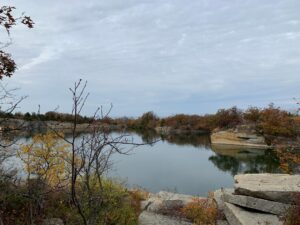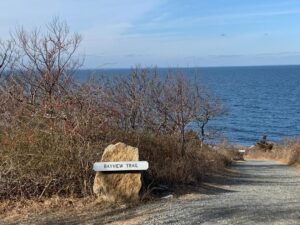The Spectacular Seasons of Halibut Point
Story and Photos by Caryn Coyle
The quarry at Halibut Point in Rockport, overwhelms with spectacular beauty. It is discovered after a short walk along a cedar chip path, surrounded by an abundance of trees. Originally called “Haul-About,” Halibut Point’s location is where the prevailing winds shift and sailors need to change the direction of their sails.
 In summer, the water shimmers on the quarry. It is cooler here and the foliage that frames it is lush. Ducks move over the water in a straight line. A park official told me that the quarry is filled with fresh water from the rain and snow accumulated since the quarry was dug. For a century, beginning in 1840, granite was quarried at Halibut Point. It was a large operation that paved thousands of city streets, tunnels, monuments, warehouses and buildings. Quarry from Halibut Point also built bridges, like the Longfellow Bridge in Boston.
In summer, the water shimmers on the quarry. It is cooler here and the foliage that frames it is lush. Ducks move over the water in a straight line. A park official told me that the quarry is filled with fresh water from the rain and snow accumulated since the quarry was dug. For a century, beginning in 1840, granite was quarried at Halibut Point. It was a large operation that paved thousands of city streets, tunnels, monuments, warehouses and buildings. Quarry from Halibut Point also built bridges, like the Longfellow Bridge in Boston.
From the quarry, I can see the Atlantic over the green that tops the quarry’s boulders. I walk to Halibut Point’s bayview trail and climb carefully down on the rocks to the water. The small, scratchy barnacles on the jagged surfaces are annoying, but navigable. The ocean is splashing gently against the boulders about fifteen feet from me.
The sky is light blue with a wash of clouds at the horizon and I head up to the lookout from the bayview trail.
Standing at the edge, just far enough back from the boulders, I heed a sign that warns me that the rocks are dangerous. I am about five or six stories above the Atlantic, here. Near me is a flat area of black and white speckled rock. A straight path down to the ocean has been carved out of the stone, but it is “closed.”
The blue of the water is darker here than it is at sea level on the bayview trail. Waves, crested with white, roll over the boulders and many are partially submerged in the water. I can see the mouth of the Merrimac River and Plum Island before I head back to the cedar chip path by the quarry.
 When I return to Halibut Point, the foliage has changed. The leaves have turned yellow and I spot some bright red, too. When I sit on a stone bench near the edge of the quarry, the view is breathtaking. The color of the quarry stone is beige and darker in spots, mixed with brown. In some areas, the stone is brighter, almost white, and I can make out the black specks that are peppered throughout the granite. When the hundred-year-old Longfellow Bridge was restored about a decade ago, the unique Halibut Point granite was no longer available. But the granite stripped from the Hines Memorial Bridge in Amesbury when it was reconstructed, was from Halibut Point and perfect to complete the task on the Longfellow Bridge.
When I return to Halibut Point, the foliage has changed. The leaves have turned yellow and I spot some bright red, too. When I sit on a stone bench near the edge of the quarry, the view is breathtaking. The color of the quarry stone is beige and darker in spots, mixed with brown. In some areas, the stone is brighter, almost white, and I can make out the black specks that are peppered throughout the granite. When the hundred-year-old Longfellow Bridge was restored about a decade ago, the unique Halibut Point granite was no longer available. But the granite stripped from the Hines Memorial Bridge in Amesbury when it was reconstructed, was from Halibut Point and perfect to complete the task on the Longfellow Bridge.
The granite and the fall foliage are reflected on the surface of the quarry water. The water is so dark, it actually looks black. Above the quarry, I search for the Atlantic. It is a deep gray and I can hear the waves.
At the bayview trail again, I climb down, over the barnacles and boulders, to the spot on which I like to sit. I can hear the crashing, roaring Atlantic and the water is a steel blue with white caps. The horizon is so clear, I can see the Isles of Shoals, the faint, bluish, ragged outline of the ocean border between New Hampshire and Maine.
Here, the waves splash spectacularly, exploding over the rocks along the shore. It sounds like the roar of traffic. Birds float and flutter their wings above the water beneath me and more scout the left over twigs sticking up from the rocks that line the water.
In 1814, the British landed near here. General Appleton of Gloucester marched fifteen hundred men down to Halibut Point, before the commander of the British frigate set sail and fled, firing some parting shots that did not hit anyone.
Halibut Point’s visitor center was once a World War II artillery tower, built with a steeple to disguise it as a church. The building was used to watch for German submarines crossing the Atlantic.
 In winter, when most of the quarry’s foliage is gone, what remains are dark branches. Part of the quarry’s surface has turned to ice. It is still, with a smooth surface along a jagged border. On the part that is not frozen, the wind makes the water look like coins where the sun hits it. Thousands of coins, floating over the water and disappearing.
In winter, when most of the quarry’s foliage is gone, what remains are dark branches. Part of the quarry’s surface has turned to ice. It is still, with a smooth surface along a jagged border. On the part that is not frozen, the wind makes the water look like coins where the sun hits it. Thousands of coins, floating over the water and disappearing.
Winter lasts a long time in New England and the gray landscape, everywhere, can be monotonous. But Halibut Point offers a reprieve. While the foliage hibernates in gray, the blue seascapes at the quarry and the Atlantic mix with the lighter colors of the granite.
Then, four ducks appear on the quarry. They swim side by side, on the “coins” of the water, far from the ice.
Nicely done, Caryn. You’re quite the photographer too.
Thanks, Claire!
I love Halibut Point and I feel that you’ve conveyed a good sense of its winter allure.
Thanks, Pat!
Love Halibut Point. This brought me right back there.